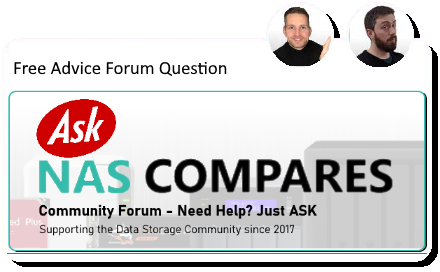04-16-2025, 09:10 PM
Hi Everyone,
I am looking for some advice before I upgrade my existing NAS, to get a few opinions on how others would proceed.
I currently have a supermicro 3U 16 Bay chassis, supporting E-ATX and ATX mobos, with a supermicro motherboard (X9DRD-7LN4F). It is quite old, but I have specced it out with a full dual power supply for resiliency, low-ish (for a server, but still relatively loud) volume fans, etc. It has dual E5-2620 V2 (CPU Mark 6250 x2 = 12500), with no QuickSync. It has all 16 bays used (a couple SSDs for OS/VMs), though about 10 smaller disks that could be amalgamated with buying ~3 new large disks . I have added an Nvidia GPU to do transcoding in plex.
I currently have it running Windows Server 2019, with StableBit DrivePool and snapraid to allow me to use different size disks. I use it as a home lab, primarily running plex, but running a few various VMs for different functions that are not very intensive.
I have had it for a few years, and I have looked into what my options are, as it is very power hungry (using maybe 20% of the power of my entire home), noisy (not a huge deal, as I have it in a basement), and large. Additionally I want to add HomeAssistant to this setup, but I am unable to pass through dongles for Zigbee, matter and Z-wave as required due to hyper-v restrictions.
Summary:
Current Specs:
My current issues with this setup:
My future plans:
I am in no huge rush to replace this, I can run as is for a few years if needed before needing a major upgrade (at longest Jan 2029 when Server 2019 goes EoL), but I likely will need to procure something in the interim for Home Assistant (HA Green/Raspberry Pi), which then may be wasted when I upgrade this.
My Questions:
Thanks for the support!!
I am looking for some advice before I upgrade my existing NAS, to get a few opinions on how others would proceed.
I currently have a supermicro 3U 16 Bay chassis, supporting E-ATX and ATX mobos, with a supermicro motherboard (X9DRD-7LN4F). It is quite old, but I have specced it out with a full dual power supply for resiliency, low-ish (for a server, but still relatively loud) volume fans, etc. It has dual E5-2620 V2 (CPU Mark 6250 x2 = 12500), with no QuickSync. It has all 16 bays used (a couple SSDs for OS/VMs), though about 10 smaller disks that could be amalgamated with buying ~3 new large disks . I have added an Nvidia GPU to do transcoding in plex.
I currently have it running Windows Server 2019, with StableBit DrivePool and snapraid to allow me to use different size disks. I use it as a home lab, primarily running plex, but running a few various VMs for different functions that are not very intensive.
I have had it for a few years, and I have looked into what my options are, as it is very power hungry (using maybe 20% of the power of my entire home), noisy (not a huge deal, as I have it in a basement), and large. Additionally I want to add HomeAssistant to this setup, but I am unable to pass through dongles for Zigbee, matter and Z-wave as required due to hyper-v restrictions.
Summary:
Current Specs:
- SuperMicro Chassis/Motherboard
- 64GB Ram
- Dual E5-2620 V2 (CPU Mark 6250 x2 = 12500)
- Windows Server 2019 with VMs for various functions
- SnapRAID and DrivePool to manage data
My current issues with this setup:
- Power Hungry (and loud)
- Unable to pass through dongles for z-wave etc. to allow home assistant use (will otherwise likely buy a mini-pc/rpi)
- Annoying to use containers within a Host > VM > Container setup, as opposed to directly on the host. Not the end of the world, but adds a bit of complexity.
My future plans:
- Implement Home Assistant
- Likely move to UnRaid (I already own a perpetual license)
- Utilize a bunch more containers for various aspects, some of which are being done inside VMs now, some would be net new
- Replace hardware (Motherboard/CPU) with something more modern
- No need for GPU, as quicksync would cover transcoding
I am in no huge rush to replace this, I can run as is for a few years if needed before needing a major upgrade (at longest Jan 2029 when Server 2019 goes EoL), but I likely will need to procure something in the interim for Home Assistant (HA Green/Raspberry Pi), which then may be wasted when I upgrade this.
My Questions:
- Based on my above specs, do people here think the value is in buying net new everything (besides disks, but I guess even the small disks could be replaced), or utilize the existing chassis, and fit a new (probably non-server grade) motherboard inside it?
- Will I get value in upgrading to one of the recommended mobo/cpu combos with higher specs, mostly from an energy saving perspective? This server costs me ~20USD/month in electricity to run, but I am not aware of how much is Disks and PSUs (which likely would remain) vs the other.
Thanks for the support!!





